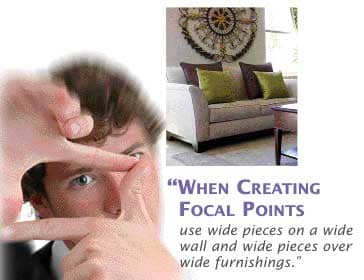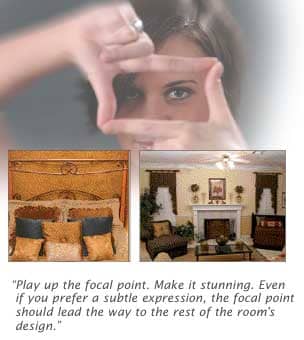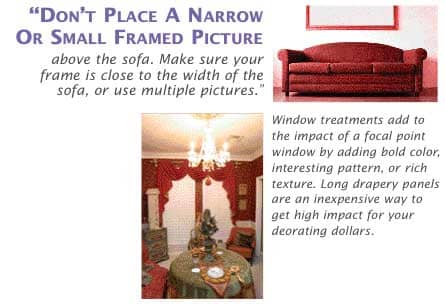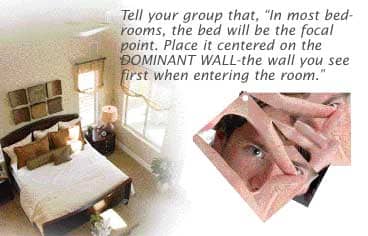Lesson #4: How to put on the customer design seminar,“Center Stage: Show Stopping Design Through Understanding Focal Points.”
Editor’s note: This is the fourth article in our Decorating Crash Course series. The text is written so that you can easily use it to put on a customer seminar on focal points. It can be presented “as is” but you should add additional elements to give your seminars a personal touch as outlined in the December/January 2007 issue of FURNITURE WORLD Magazine, “Simple but Sensational Seminars: Keys to a Memorable Presentation,” posted to the article archives on www.furninfo.com. Quotation marks only appear at the very beginning and end of the “sample seminar script” for ease of presentation.
Decorating seminars are a fantastic way to get quality leads and referrals. They help customers to solve decorating problems, and they position you as a home furnishings expert.
Focus: noun. 1. A place of concentrated activity, influence, or importance. 2. A point of origin from which ideas or influences, for example, originate. Source: Answers.com.
SAMPLE SEMINAR SCRIPT
“There is no doubt about it. Great room design depends on creating or working around a clear and attractive focal point. A room’s focal point sets the stage for mood and style and is closely tied to the principle of emphasis. The focal point is the element in the room that immediately draws your attention. It is the place of subtle (and sometimes not so subtle) impact, and the area of design that all the other elements relate to. Once a focal point is established, all of the furnishings and pieces in the space will be positioned either facing it or relating to it. Good furniture placement and successful accessorizing depend on the focal point. Establishing a focal point is where you should start to create your beautiful room.

Natural Focal Points
Many rooms have a natural focal point built right in, such as a fireplace or large window. This takes the guesswork out of where to start with your room design. Other natural focal points include built-in cabinets or bookshelves, painted murals, or areas of architectural interest that have been built into the home.
In a bedroom, the focal point will typically be the bed, and in the dining room, it will likely be a beautiful china cabinet, an elaborate buffet, or a buffet area. The obvious and ideal place for the placement of a focal point is on the focal wall.
The focal wall is the wall you notice first when entering the room. Your focal point will usually be placed on this wall.
Create a Focal Point
If a room does not have a natural focal point, you must “create” one. Creating a focal point where there is no natural architectural emphasis can seem challenging, but in fact, it is a simple process. The key is to fill up a good portion of the focal wall in a pleasing arrangement that uses color, shape, texture, and balance in a harmonious way.
Start by selecting the room’s largest piece of furniture (other than an upholstered piece) such as an armoire, grand bookcase, or entertainment center. The sheer size of such a piece will usually command visual attention as well as take up a substantial amount of space. Create the actual focal point “arrangement” by placing this large piece of furniture on the focal wall. Now, play up this piece with a tasteful selection of decorative accessories. Use a mixture of color and texture as you accent the focus area. Use varying heights and visual weights of accessory objects to add impact and interest.

Play Up the Focal Point
Play up the focal point. Make it stunning. Even if you prefer a subtle expression, the focal point should lead the way to the rest of the room’s design. Begin by painting the focal wall a color that is a couple of shades deeper than the existing wall color, or if your walls are neutral, choose a rich or vibrant color for the focal wall. This will ensure a fully supportive backdrop that will make your focal point really come to life.
Now accessorize the focal furnishing piece. If your focus is a mantle, celebrate it with a grand display, perhaps flanking a large and beautifully framed picture with tall topiary floral arrangements. If the focal point is a bed or sofa, dress it with beautiful, welcoming accent pillows and a fringed throw. Decorate a hutch or china cabinet with exquisite glassware, perhaps add “pops” of color or unusual pattern. Adorn a bookshelf with small framed artwork on mini-easels, vases of varying heights and textures, and beautifully bound books grouped by color. Enlarge the area of a fireplace or buffet with accent chairs placed on either side, upholstered in ornate fabrics, and accented with trim or tassels.
Using the Sofa as the Focal Point
In a living room, if there is not a large case piece such as an armoire, bookcase, T.V. or entertainment center available, the sofa can serve as a focal point if the wall above it is played up with a large mirror or interesting piece of framed art that takes up the approximate width of the sofa. However, don’t make the mistake of placing a narrow or small framed picture above the sofa. Make sure your frame is close to the width of the sofa, or use multiple pictures hung together to take up the space.
Be certain to leave enough space between the top of the sofa and the bottom of the framed piece so that people sitting on the sofa do not hit their heads against the art or mirror. Also, try to pull the sofa away from the wall a bit as long as the look is pleasing, a term known as “floating” the sofa.
There will be times when you must use the sofa as a focal point, but if there is no clear focal wall, or no large mirror or piece of art to work with, try to caddy corner the sofa and add a screen or plant behind it to create an emphasis point in the space. Another option is to place a low setting table or sofa table behind the sofa, and place tall candle holders, lamps, plants or other tall accessories on top so they are visible behind the sofa and ad to the unity of the area. Emphasize color and texture on accessories through items such as silk lampshades, oversized candles, and stunning floral arrangements.

Use Wide with Wide
An important thing to remember when creating focal points is to use wide pieces on a wide wall and wide pieces over wide furnishings. If this is not possible, then create visual width. For example, if a wide sofa placed on a focal wall must become the focal point, and the only piece you have to hang above the sofa is a small mirror, create more visual width by flanking the mirror with matching sconces, shelves, or pieces of coordinate art in similar or matching frames.
Focal Point in the Dining Area
Contrary to what many people believe, in a dining area the table is not normally the focal point. A good area for emphasis in the dining area is a grand china cabinet containing unusual china or glass pieces. The dining area focal point can also be a treated window or a buffet table with a large, ornately framed mirror above. In the latter case, the buffet could be embellished and played up with accents such as a glamorous table runner, tall, chunky candlesticks with candles, and a striking floral arrangement centerpiece, for example.
Focal Point in the Bedroom
In most bedrooms, the bed will be the focal point. Place it centered on the dominant wall, the wall you see first when entering the room.
Since the bed is the focal point, accent it with beautiful linens and pillows, and perhaps a canopy or gorgeous headboard. If you don’t have a striking headboard, create one! You can use a decorative screen, large European pillows, or draped fabric or fabric panels as a type of headboard. Accent the bed with a throw.
Since many bedrooms are small or have multiple doors and windows that infringe on the space, you could try arranging the bed in a corner. In certain rooms, this will free up space, visually enlarge it, and add romance and drama.
For bedrooms with a natural fireplace focal point, you may want to emphasize the mantel area above the fireplace, and downplay the bed just a bit so as not to create “eye competition”. Dress the bed simply with a subdued spread or coverlet and skip the collection of trimmed pillows, opting instead for a pair of flanged or corded shams.

Focal Point in a Multi Purpose Room
Each “room” within the multipurpose room should have an anchor or a dominant feature or focal point. Treat the distinct areas in a large, open, or multipurpose room as separate areas, while at the same time allowing them to flow together visually. Each space should have it’s own focal point. The focal point pieces should be placed so that the entire multipurpose area has balanced weight. This usually means two large pieces will be opposite each other in the overall, large multipurpose space.
Focal Point Window
If the focal point is a large window, dress it so that full and luscious fabric panels flow from near ceiling to floor, emphasizing the height of the window, and framing the view.
Window treatments will add to the impact of a focal point window by adding bold color, interesting pattern, or rich texture at the window. Long drapery panels are an inexpensive way to get high impact for your decorating dollars, and gorgeous panels can be found in many furniture and home accessory stores. Even if a room has two small windows side by side, you can create a wide focal point with window treatments, visually expanding the size of the windows through the design of the treatment. You can add drama with luxurious fabrics such as silk or brocade in beautiful designs. Lining and interlining add to the glamorous affect, offering a grand and stately view of the focal point from inside the room.
Multiple Focal Points
Too many areas of emphasis can take away from the beauty of your room design, and cause the space to feel unbalanced. Some homes have rooms with more than one natural focal point, such as a fireplace and large picture window. If the window exhibits a fantastic view, this will be your focal point and you should dress it accordingly.
Other rooms have a natural focal point such as a fireplace, which must share the space with a very large piece of furniture such as a grand entertainment center. How do you decide which is the focal point? Choose the focus area that catches your attention first as you enter into the room, or the area the other furnishings will relate to most (that they will likely face). Give this furnishing the most attention. Make it the priority. Allow the “secondary” emphasis area to have more of a supporting role, without much ornament, and leave the most attention gaining accessories for the major focal piece.
8 Focal Point Basics
•The Focal Point is the design element that catches your
attention immediately. It is the emphasis point.
•It is likely a natural feature of the room, such as fireplace, a big window, or built in.
•If a room does not have a natural focal point you can create one using a large piece of furniture, or a smaller furniture piece accented with other accessories to visually expand the size of the emphasis area.
•When creating a focal point, place the Focal Point Item against a wall. This will most likely be the dominant wall, the wall you notice first when you enter the room. This wall can be painted an accent color that is different from the other walls.
•Play up and decorate the focal point. Mantels especially
provide a great opportunity to create a wonderful
presentation. Let the focal point make a glamorous,
dramatic, or grand statement.
•If you are using a low piece of furniture such as a buffet as a focal point, you must dress up the area above it to make an impact. Use a large picture, mirror, and accessories to scale.
•Leave some space around the focal point so the elements can “breathe”.
•Furnishings should be arranged to enhance or support the room’s focal point. Always place furniture facing, or in direct relation to the room’s focal point (more on this in the next issue-we can’t let the porcelain cat out of the bag).
A Call to Action
It’s time to take action to beautify your interior spaces. Pick one room in your home (or an entry way, large hall area, or foyer) that does not have a clearly established or beautifully embellished focal point. Establish the basic focal point such as a fireplace or buffet with large mirror above (in a bedroom, really play up the bed). Now, Embellish Away! Have fun making it the star. Start by laying down a colorful fabric accessory with a beautiful pattern or interesting texture, such as a runner or mantle scarf, to add visual interest to the space. Next, place an anchor item— a stunning floral centerpiece for example— on the shelf or buffet. Flank it with simple yet elegant tall candle holders.
Experiment with accenting the focal point area with a number of different accessories until you find the combination that feels good in your “gut”. Believe me, this is not a strict science, and there are many possible combinations that will work sensationally. Just pick one! You can always change it later, or present seasonal displays during different times of the year. The main objective here is to Just Start! Taking action breaks the fear-based thoughts that you may not do it “right”. Forget all that, and have fun experimenting with accessories taken from different rooms until the arrangement is one that is attractive and eye-catching, and serves the focal point area well.
Conclusion
Understanding focal points is a giant step in good home design, and establishing a focal point in each room is essential. Interior spaces need an area of emphasis for visual impact as well as a center of interest that other design elements can relate to. Establishing a focal point in your interior spaces will give your rooms a sense of life and character, and will help to bring all of the elements into a cohesive, balanced, and harmonious whole.”
Next issue
Lesson #5 – Furniture Placement Strategies to Bring Your Rooms to Life—Know them to Live Well.
Margarett DeGange, M.Ed. is a Home Fashions designer, Writer, and Professional Speaker. She is the creator of Communicate 2 Connect Seminars for business and personal development, and she is the Founder and Director of The DeGangi School of Interior Decoration, with both on sight and on-line courses in Interior Decorating and Redesign. For the past 20 years she has helped business owners in the interior fashions and decorating industries to communicate better with customers, run their businesses more effectively, and increase sales and profits. Questions can be directed to Margarett DeGange at margarett@furninfo.com